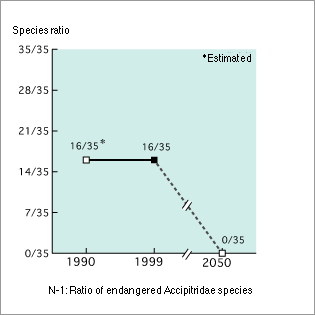ProjectsPast and current JFS projects
Indicators - Nature / Biodiversity
N-1. Species of Accipitridae Family in Danger of Extinction
1.Current Values16 / 35 species (2002)
2.Current Points
(out of a perfect score of 100 by 2050) 54 points
Calculation method:
(100% - (endangered species/total species) x 100)
3. Explanation of Indicator
In a sustainable society biodiversity is maintained. For the species of the family Accipitridae to thrive in it, a habitat needs to be a large, well-preserved, favorable natural environment area with a stable and plentiful supply of prey rich in diversity. For this reason the habitation status of the Accipitridae can be an indicator by which to comprehensively measure the quality of an ecosystem.
Substances such as environmental hormones can easily accumulate, as in high-end consumers and it is thought that where a change in the Accipitridae has occurred, this means there is a high likelihood that the amount of harmful chemical substances present in the region has reached a level that could affect the humans who live there as well. Thus [the Accipitridae] become a barometer for gauging quality and changes in the ecosystem.
4.Target for 2050
0 / 35 species
5.Ideal for the Future
0 / 35 species
6. Rationale for Ideal and Target Values
The Accipitridae species, as high-end consumers standing atop an ecological pyramid, play a role in maintaining balance in the ecosystem. There is a danger that their extinction or reduction in their number would bring forth a spike in subpopulation, and thus the preservation of the Accipitridae is important to preserving a stable ecosystem.
At present, there are two families and 29 species (35 species including subspecies) confirmed to be living in Japan and, of those, 16 species are in danger of extinction. The future ideal is for all the species that have been presently confirmed to be endangered to emerge from the endangered status.
7. Source
Japanese Ministry of the Environment's Biodiversity Information System Red Data Book
Related information: Extinct and Endangered Species Listed in the Red Data Book



